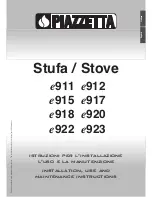
7
Temco DV5200, DV6400DSN/DSP Series
77794
Combustible Material
2 x 4 Stud
2 x 4 Header
Standoff
Combustible Material
Above Standoff
Optional Hearth
Minimum Height from
Top Opening to Mantel
T178
Fig. 7 Gas fireplace installation.
NOTE: Please remember this appliance produces
heat. All clearances are to combustible material and
are not intended to cover temperatures at which some
materials may discolor, warp or produce odor when
exposed to temperatures which this unit produces.
DV5200 / DV6400
Certified To
ANSI Z21.88-2000/CSA 2.33--2000/UL 307B
Vented Gas Fireplace Heater
Gas Inlet and Manifold Pressures
Natural
LP (Propane)
Minimum Inlet Pressure
4.5” w.c.
10.8” w.c.
Maximum Inlet Pressure
14.0” w.c.
14.0” w.c.
Manifold Pressure
3.5” w.c.
10.0” w.c.
Gas Specifications
Max.
Min.
Gas
Input
Input
Model
Fuel
Control
BTU/h
BTU/h
DV5200N
Natural
Hi/Lo
25,000
17,000
DV5200P
Propane
Hi/Lo
25,000
17,500
DV6400N
Natural
Hi/Lo
27, 000
18,000
DV6400P
Propane
Hi/Lo
25,000
17,500
Gas Line Installation
This gas appliance should be installed by a qualified
installer in accordance with local building codes and
with current CSA-B149.1 installation codes for Gas
Burning Appliances and Equipment in Canada and the
National Fuel Gas Code ANSI Z223.1/NFPA 54 in the
U.S.A.*
1. The gas pipeline can be brought in through the
bottom or the right or the left side of the appliance.
A hole is provided at all locations to allow for the
gas pipe installation and testing of any gas connec-
tion.
2. The gas control inlet is 3/8" NPT. Typical installation
layout for rigid pipe is shown on Page 8.
NOTE: All models are equipped with a flex tube
with a shut off valve having a 1/2” NPT inlet. The
flex line with shut off is shipped in the control
valve compartment. Using two wrenches,
tighten the flexible tube at the shut off valve and
at the gas control.
3. When using a flex connector,* use only approved
fittings. When a union is installed, provide easy
access in it’s placement for servicing. Refer to gas
specification for pressure details and ratings.
4. When a vertical section of gas pipe is required for
the installation, a condensation trap is needed. In
Canada see CSA - B149.1 for code details. See
the National Fuel Gas Code ANSI Z223.1/NFPA 54
in the USA.
5. For natural gas, a minimum of 3/8" iron pipe with a
gas supply pressure of 4.5" w.c. (from the gas
meter). Consult with local gas utility and
ANSI223.1/NFPA 54 if any questions arise concern-
ing pipe sizes.
6. Turn the gas supply to 'ON' and check for leaks.
DO NOT USE OPEN FLAME FOR THIS PUR-
POSE. Use an approved leak testing solution.
7. The appliance and its appliance main gas valve
must be disconnected from the gas supply piping
system during any pressure testing of that system at
test pressures in excess of 1/2psig (3.5 KPa).
8. The appliance must be isolated from the gas supply
piping system by closing its equipment shut off
valve during any pressure testing of the gas supply
piping system at test pressures equal to or less than
1/2psig (3.5KPa).
NOTE: The gas line connection may be made of 3/8"
minimum rigid pipe, 3/8” minimum copper pipe or an
approved flex connector. Since some municipalities
have additional local codes, it is always best to consult
your local authorities and the current CSA-B149.1
installation code in Canada or National Fuel Gas Code
ANSI Z223.1/NFPA 54 in the U.S.A.
*Adhere to the following installation requirements in the State
of Massachusetts:
•
The installer must be a licensed plumber or gas fitter.
•
Flex connectors must be Massachusetts approved,
cannot exceed 36” (914mm) in length, must be a mini-
mum 1/2” dia., and may not penetrate a wall.








































